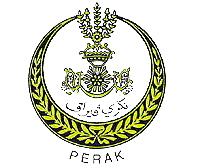Perak covers an area of 21,000 sq km and has a population of about 2 million.
For centuries, Perak has been well known for its rich tin deposits. It is believed that the state derived its name, which means silver in Malay, from the silvery tin ore.
The discovery of tin by Long Jaafar also brought about an influx of Chinese immigrants to Perak. Today, Perak has developed into a harmonious multi-racial society characterized by a diversity of language, culture, and heritage.
Perak Area: 21 005 square km
Perak Capital: Ipoh
Perak Royal Town: Kuala Kangsar
Perak Administrative Divisions: Batang Padang, Manjung, Hilir Perak, Kerian, Kinta, Kuala Kangsar, Larut and Matang, Perak Tengah, Hulu Perak
Going to Perak
By road, Ipoh is only 205 km from Kuala Lumpur and 165 km from Penang.
Trains ply along the Kuala Lumpur-Ipoh-Butterworth route.
Fireflyz airlines fly from Singapore to Sultan Azlan Shah Airport near Ipoh.
Perak Emblem

The crest on the Sultan’s head-cloth is the symbol of his sovereignty, the crescent moon is the symbol of Islam and the rice flower denotes paddy planting, the people’s main occupation.
Perak Flag
The State Flag is divided into three equal horizontal stripes. The three colors represent the three branches of the royal family whereby the throne is shared in rotation. The white stripe symbolizes the Sultan while the yellow stripe is that of the Raja Muda. The black stripe represents the Raja DiHilir.
Perak History
Early Perak kingdoms existed in the settlements of Dinding, Beruas, and Manjung. However, the present sultanate has its origins from the Melaka Sultanate. Perak was established in 1528 and the first sultan of Perak was Sultan Muzaffar Syah, a decendent of Sultan Mahmud Shah of Melaka.
Perak was constantly menaced by regional powers. The Achinese plundered the state in the 16th century, while the Dutch in 1641 tried to establish a monopoly on Perak’s tin trade by building a fort on Pangkor Island. The Bugis and Siamese posed further threats to Perak in the 18th century. Among all the external influences, the Siamese presented the biggest threat.
Internally, Perak was embroiled in a throne succession war in the 1870s between Raja Yusuf, Raja Ismail, and Raja Abdullah. Adding to the air of strife was the rivalry between factions of the Chinese. By the mid-nineteenth century, the Chinese presence in Malaya was considerable, with immigration being spurred by the growing tin industry. With its abundant cache of tin, Perak was one of the favored destinations for incoming workers. This immigration also brought the social order of secret societies. By the 1870s, there was an ongoing dispute between the rival Chinese clans of Ghee Hin and Hai San. This led to British intervention in order to protect their interests in Perak.
The Malay chiefs and clan leaders were summoned to a conference onboard the British ship, Pluto, at Pangkor Island in 1874. On 20 January 1874, the Pangkor Treaty was signed. With the signing of the Pangkor Treaty, Raja Abdullah has conferred the sultanate and J.W.W. Birch was appointed the first British Resident. Disgruntled by the forceful implementation of British interest with little regard for their own, a number of Malay leaders planned the assassination of Birch in 1875. Several Malay nobles such as Sultan Abdullah, Dato’ Maharajalela, Ngah Ibrahim, and Dato’ Sagor were implicated in the plot and were subsequently sentenced to death or exiled.
In 1896, Perak became a Federated Malay State, which lasted until the Japanese invasion. When the Japanese withdrew in September 1945, the British Military Administration (BMA) took over.
The British in London formed the Malayan Peninsula Planning Unit in 1943, and on 10 October 1945, the Malayan Union scheme was laid out before the British Parliament. A day later, Sir Harold MacMichael was sent to the Malayan Peninsula to obtain the agreement of the Malay Rulers. According to this agreement, Pulau Pinang, Melaka, and nine other Malay states were united under the Malayan Union.
Malay opposition derailed the Malayan Union plan, and the Malays under Dato’ Onn Jaafar’s leadership formed the United Malays National Organisation (UMNO) on 11 May 1946. The Malay Federation was founded on 1 February 1948, the first step towards independence, and on 31 August 1957, independence was achieved.
Perak Shopping
There are many modern shopping centers and supermarkets in Perak, especially in Ipoh and the major towns. Other places where you can pick up good bargains are at the Pasar Malam or night markets. These are street bazaars that stock everything from local handicrafts to folk medicine, from farm-fresh produce to casual wear.
Shopping Malls in Perak
- Ipoh Parade
- Greentown Mall
- Kinta City Shopping Centre
- Ipoh Garden Plaza Shopping Centre
- Super Kinta
- Ocean
- Megoplex
- Billion
- Makro
- The Store
Perak Travel
Perak is known for its abundant tin fields and is the principal tin mining area in Peninsular Malaysia. But there are also many other places of interest. Night markets are great for bargain shopping for items like handicrafts, local fruits, clothes, and household utensils. Waterfalls, caves, museums, parks, and historical landmarks make Perak an interesting tourist destination.
Perak Places of Interest
- Bukit Larut (Maxwell Hill)
- Dutch Fort
- Kellie’s Castle
- Lumut
- Pasir Salak Historical Complex
- Perak Cave
- Perak Museum, Taiping
- Pulau Pangkor
- Pulau Pangkor Laut
- Pulau Sembilan
- Sam Poh Tong Temple
- Taiping Lake Gardens
- Teluk Batik
- Tempurung Cave
- The Leaning Tower of Teluk Intan
- Ubudiah Mosque
Click here to learn about Penang.
